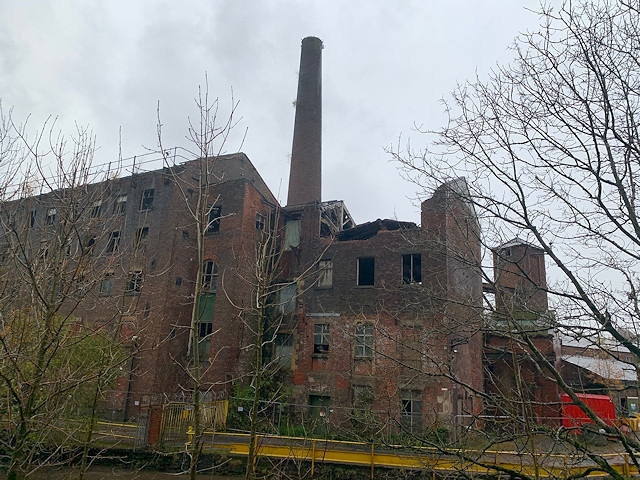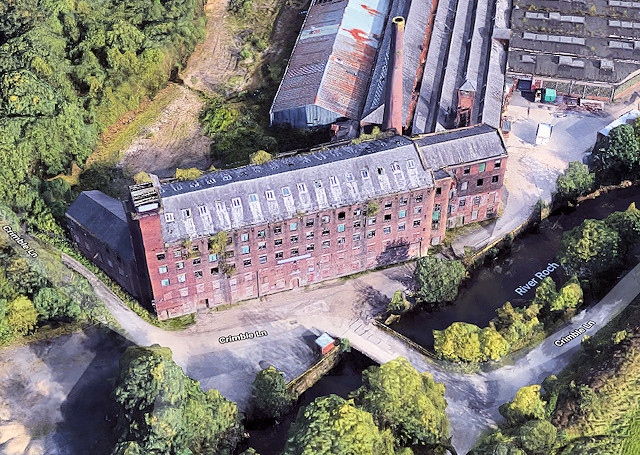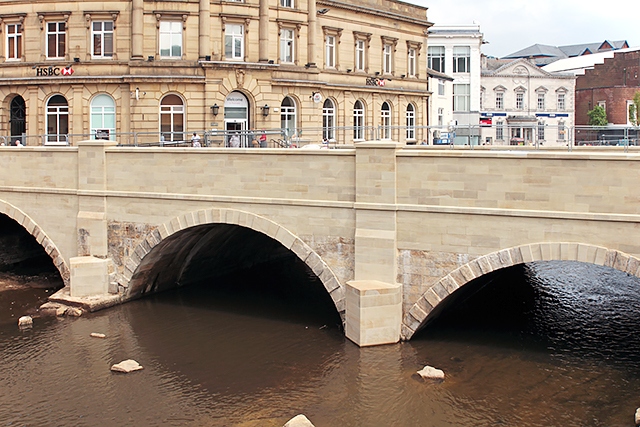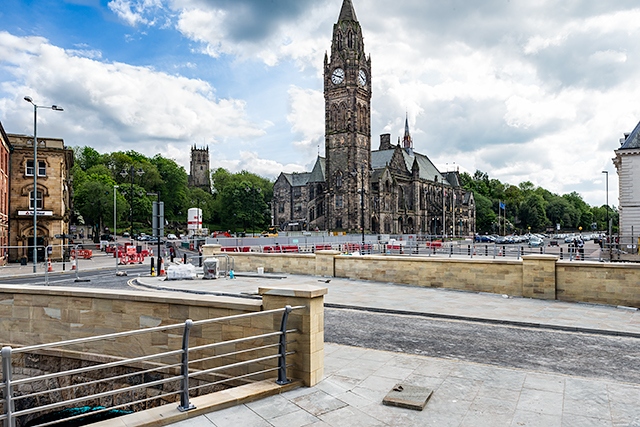Mill chimney and bridge added to National Heritage List for England in 2019
Date published: 31 December 2019

Photo: Paul Arden
The chimney at Crimble Mill
Two historic places in the Rochdale borough have been added to the National Heritage List for England this year.
Both the Crimble Mill’s chimney in Heywood and the Rochdale Bridge, at the junction of The Esplanade, Yorkshire Street, The Butts and South Parade in Rochdale have been Grade-II listed in 2019.
Crimble Mill chimney
The mill chimney, built in the early 20th century, has been listed as Grade-II for its architectural interest as “an increasingly rare survival of an extant mill chimney and a distinctive component of steam-powered mills”, historic interest and group value.
Historic England says the chimney demonstrates the “on-going importance of steam power in mill complexes into the 20th century, replacing an earlier chimney built in the 1850s, which in turn was part of a new power transmission system which superseded waterpower used in the early-19th century mill.”
The chimney is likely to have been constructed around 1859 along with an engine house, adjoining fire-proof warehouse and a possible boiler house in a single phase of construction.

The Crimble Mill site, itself a Grade-II* listed building, originated as a water-powered fulling mill, said to have been built in 1761 by the Kenyon family. In July 1822, this building was put up for auction following the death of John Kenyon.
The highest bidder was Charles Stott, a cotton spinner and fustian manufacturer of Castleton, and the building was released into his ownership in 1825.
Shortly after the purchase, Stott built a new water-powered cotton mill on the site of the old mill.
In the 1930s further additions were made to the complex to enable Crimble Mill to take over the finishing of all woollen goods for James Kenyon and sons’ operations.
During World War Two, the mill supplied paper makers’ felt, duffle coating and felts used to seal bullet holes in aeroplanes’ petrol engines.
After World War Two, further buildings were added to the complex. The mill was first listed on the National Heritage List for England in 1967.
In 1968, James Kenyon & Son Limited was sold to Albany Felt Company of Albany, New York. Two years later the site was taken over by Roeacre Dyeing and Spinning Company of Heywood (later Roeacre Dyeing and Felting Company). Roeacre Dyeing and Felting Company went into receivership in 2002 and closed.
Much of the site has been vacant since then.
Rochdale Bridge
The bridge in the centre of Rochdale has been listed for its architectural interest as a multi-phased bridge originating in medieval times, its historic interest showing “a considerable investment in the pre-industrial transport infrastructure of Rochdale, suggesting the growth of the settlement” and for its links to nearby historic listed buildings, such as the Grade-I listed town hall and the Grade-II listed former Post Office.
Rochdale Bridge is the core historical bridge comprised of five phases from medieval to regency periods in date. The building of the first phase of the bridge is most likely to have occurred in the 13th or early 14th century.
The original Rochdale Bridge is medieval, although the date of its construction is not known. The narrow three-span masonry bridge had a pointed central arch flanked by round outer arches, a style characteristic of bridges built between 1200 and 1600.

In 1667, the medieval bridge had a narrow bridge extension built abutting its east side, widening the bridge to allow two carriages or carts to pass simultaneously. The new bridge was also of three spans with round outer arches and a pointed central arch, though the crown of the arch was slightly higher than the original.
It appears that the southern arch of the medieval bridge may have been rebuilt at this time as the masonry differs from that of the rest of the bridge, using smaller stones.
An ever-increasing flow of traffic over the course of the 18th century led to widenings of the bridge on both sides. The first is likely to have been installed before 1787, followed by further amendments in 1821 and 1864.
In May 1903, the covering of the River Roch began, to hide the polluted river from view. Further extensions of the river covering were undertaken in the early 1920s.
In March 2015 work started on a restoration project to reopen the river, reinstating the bridge as an entity and also a reduced flood risk.
The outer walls of the re-exposed bridge required restoration work as they had been damaged by the later extensions. In addition, new parapet walls were needed as the previous culverting had resulted in their removal.
The work was completed in June 2016.

Nationally, more than 500 places have been added to the National Heritage List for England this year.
Heritage Minister Helen Whately said: “England is home to many historic, iconic, and sometimes quirky sites. Protecting our heritage is of huge importance so future generations can better understand all the things that have made this nation great.
“I'm delighted that such a diverse range of important and interesting places were protected by Historic England in 2019.”
Catherine Dewar, North West Director of Historic England said: “A fascinating range of historic buildings and sites are listed each year, and 2019 is no exception. By celebrating the extraordinary historic sites which surround us we hope to inspire in people a greater interest in our shared heritage, and a commitment to pass it on.”
Do you have a story for us?
Let us know by emailing news@rochdaleonline.co.uk
All contact will be treated in confidence.
Most Viewed News Stories
- 1Drugs and cash seized during morning raids at suspected stash houses
- 2Middleton school hails another outstanding inspection result
- 3Former councillor and hospital campaigner Jean Ashworth has died
- 4Ogden family announces intention to invest £2m in Rochdale AFC
- 5No trams between Oldham and Rochdale this Sunday
To contact the Rochdale Online news desk, email news@rochdaleonline.co.uk or visit our news submission page.
To get the latest news on your desktop or mobile, follow Rochdale Online on Twitter and Facebook.


